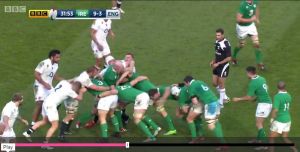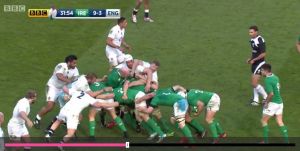The Aviva Premiership play-off final between Worcester and Bristol was rugby as it should be played; full of positive intent, creativity, bravery, controversy with a few mistakes thrown in for good measure. Unfortunately the rest of the northern hemisphere season hasn’t lived up to the same level of excitement.
Talk has already started about the latest raft of law changes that are required to make the game more entertaining but there are number of existing laws that are already in the book that need to be applied before we look at additional laws.
Here are the top 5 existing laws that we need World Rugby to instruct referees to apply:
(1) Law 15.6 – Players must be on their feet at the ruck
The illegal jackal is the bane of the modern professional game because it slows down good attacking ball and gives defences the time to reform.
The first defender at a tackle is more often than not placing his hand or hands on the floor over the ball and it is not uncommon to see an elbow resting on the floor as well. Earlier in the year in the Day of the Jackal article we looked in detail at the illegal jackal and highlighted one particular exponent – Munster and Ireland’s Peter O’Mahony. Here is a still showing O’Mahony from a 6 Nations game last year.
Law 15.6 says: After a tackle, all other players must be on their feet when they play the ball. Players are on their feet if no other part of their body is supported by the ground or players on the ground.
In the O’Mahony example a penalty was given in Ireland’s favour but O’Mahony is clearly in contravention of the law which says he must be supporting his own body weight. This isn’t an isolated example so it seems as if the governing bodies are instructing referees to turn a blind eye to law 15.6.
In the recent Munster versus Ospreys PRO12 semi final a promising attacking move by the Ospreys was thwarted by Paul O’Connell winning a jackal near the Munster line with both forearms resting on the floor.
Referees need to apply the laws as written in law 15.6 and ensure the first defender at a tackle is indeed supporting his body weight. The law itself is clear and unambiguous and it should be applied.
(2) Law 17.4 – players must join a maul from behind the hindmost player
Like the jackal law this is a clearly written directive that is ignored by top class officials to the point where it must be a conscious decision by those at the top of the officiating tree to instruct referees to ignore the law. There is no other explanation as to why all officials turn a blind eye to it.
The law says that players joining a maul must do so from behind the foot of the hindmost team-mate in the maul. The player may join alongside this player. If the player joins the maul from the opponents’ side, or in front of the hindmost team-mate, the player is offside.
Watch any maul in a top class game and you will see players from the attacking team (which controls the ball in a maul) join the maul way in front of the hind foot. This isn’t the odd sneaky player that is breaking the law but consistently every player in every game.
With this law ignored by officials it is nearly impossible to stop a well drilled rolling maul and indeed the outcome of the Worcester-Bristol semi final was largely determined by tries and yellow cards derived from illegal rolling mauls.
Again using Peter O’Mahony as an example we can see the impact of joining in front of the hindmost foot. In the first still we can see Rory Best with the white scrum cap has the ball in his possession but he is loosely bound to the player in front and the effective wedge shape hasn’t been developed. O’Mahony is at the back of the maul but is about to turn an average rolling maul in to a very effective one.
O’Mahony then joins the maul in front of the hindmost feet and the ball carrier to create a perfect wedge shape which then carries Ireland twenty metres down the field and in to a drop goal scoring position. See his body position in the screen shot below:
It is a blatantly illegal ploy but one officials turn a blind eye to in most top class fixtures. Because the rolling maul is such an attacking weapon the law needs to be applied to bring back the element of skill that used to exist – transferring the ball between players to the back of the maul.
(3) Law 16.5 – offside at the ruck
Anyone who has played organised touch rugby or rugby league will know that the offside line is rigorously policed and players have to work hard to make sure they are behind the offside line. In rugby union this line is not being policied as stringently as it should be.
At a ruck the law says that the “offside line runs through the hindmost foot of the hindmost player in the ruck” but watch most rucks and you will see players stealing half a metre or not retreating fast enough to get back on side. This means the defensive line can form and press the attacking team so putting pressure on the team with the ball.
Referees – with help from their assistants, should have a zero tolerance approach to the offside line, particularly at rucks. The law is written – it now needs to be enforced.
(4) Law 20 – the scrum and wasted minutes
After a period of some improvement in the way the scrum was managed we seem to have regressed to the point where it is a major problem again. The definitions in law 20 say that “The purpose of the scrum is to restart play quickly, safely and fairly, after a minor infringement or a stoppage.”
The word highlighted in this definition is ‘quickly’ but would most supporters define quickly as 10 second or a minute? In most games the average scrum takes nearly a minute to form once the referee has blown for the initial infringement. This is quite an incredible statistic.
In one game analysed by theblitzdefence earlier this season (Scarlets against Toulon in January 2015) the game had 17 scrums in total with the average time taken to complete the scrum being 55 seconds. Remember this is measured against the clock time so in a 80 minute game a touch over 1 in 5 minutes of the game were taken up by waiting for the scrum to form.
Not only are supporters being short changed but the speed of scrum formation is leading to the game becoming less aerobic and favouring mass over athletic ability and skill. If rugby isn’t going to become a game of giants smashing in to each other the game needs to be speed up and having the scrum form immediately after the offence is one way to go about this.
(5) Law 20.6 – feeding the ball in to the scrum
It had to be on the list somewhere! After a 2 month campaign to get scrum halves to deliver the ball directly down the centre of the tunnel this law is now ignored in most games…..until a referee decides not to ignore it!
Here is the law; “The scrum half must throw in the ball straight along the middle line, so that it first touches the ground immediately beyond the width of the nearer prop’s shoulders”.
Perhaps the least applied law of all?



Reblogged this on cornelsiobhan.
LikeLike
Here is part of a response to the article from a current referee on another forum:
“I’m rambling so i’ll highlight my key point, coaching and playing trends move faster than refereeing trends, similar to drug using and doping, we can’t referee what teams don’t try yet, and we can only react, so with a situation like ‘elbows on the ground’ it is of such minor consequence that this is allowed. If a player only has his elbow on the ground he has won the right to be there, and has a legal enough position to win the turnover as a defensive player is slow to be there. It may not be 100% correct, but it is one of the situations where refs are stronger than others.”
There are two issues with this approach which goes to the root of the article.
Firstly, the jackal having hands, arms or elbows on he ground is not a “minor consequence” – it is a source of slow ball which leads to a more defensive, slow game.
Secondly comments such as a player with his elbow on the ground “has a right to be there” and is in a “legal enough” position just shows that referees are either ignoring existing laws or providing their own (incorrect) interpretation.
LikeLike
Been thinking about #1 for a while. We need to enforce “on your feet” and encourage first arrivers to either form a standing ruck or to pick up the ball and advance it.
LikeLike
Jim – I think you are right. It is difficult to find a player on his feet at most rucks so a stronger application of the existing law would be good!
LikeLike
I notice that refs had got better in the second half of last season at responding to the off the feet clean out which is an improvement. In the last 6N there was a terrible blight with attackers simply going straight off their feet at rucks preventing a contest
LikeLike
Good points, although I have to disagree with #2 (but in turn reinforce #4!). The rule is that players must “join the maul FROM behind the hindmost…” not actually join behind. In the example O’Mahoney can be seen to do exactly that, starting behind Best but taking up position in the maul. This forces players who become detached to work around to the back of the maul and not just rejoin wherever they got spat out. If players were to always join behind the Hinckley the maul would become a conga line! As mentioned in the point on scrums, it increases the need for fitness over pure grunt too, which can only be a good thing.
LikeLike
James,
Thanks for your comments. Regarding the maul question the offside line at the maul runs through the hindmost foot of the hindmost player in the maul. Law 17.4 (c) says in full:
“Players joining the maul. Players joining a maul must do so from behind the foot of the hindmost team-mate in the maul. The player may join alongside this player. If the player joins the maul from the opponents’ side, or in front of the hindmost team-mate, the player is offside.”
LikeLike
Reblogged this on Expat Dad SG and commented:
Sharing Sunday: A good article looking at the laws that need to be enforced rather than trying to look at new rules to “fix” things.
LikeLike
A very good metaphor to use. Thanks for sharing.
LikeLike
Pingback: Enforcement of rugby laws – new for the Rugby World Cup (part 1) | theblitzdefence
Between scrums, lineouts and kicks at goal it’s a wonder we get any ball in play time at all!
LikeLike
Whilst I totally agree on the jackal is often overlooked I believe the continued allowance of sealing off at a ruck is more detrimental to a fair contest at rucks. From watching all professional rugby I would imagine that well in excess of 50% of rucks are sealed off by the tackled players teammates by either flopping, or straddling with both hands and sometimes elbows on the ground, which is rarely punished.
LikeLiked by 1 person